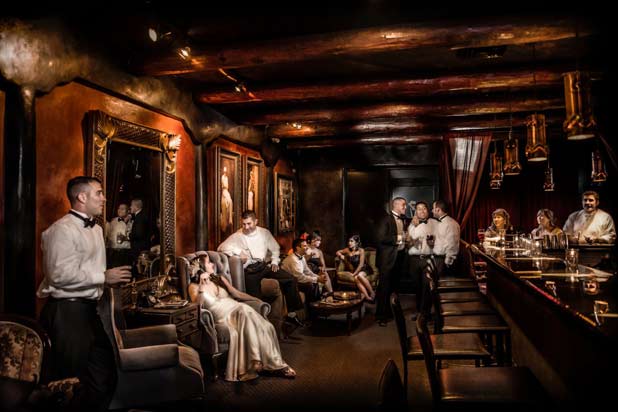 |
| Restaurants and the Mafia |
The day after Paul Castellano was rubbed out along with a top aide outside the Sparks Steak House in December 1985, the crowds were out in force. Some of the people had come to eat at the East 46th Street, Manhattan, restaurant, others merely to gawk, take pictures, and try to find bloodstains amid the drippings of oil and anti-freeze at the spot where Castellano had fallen.
In the crowd was a somber-faced restaurateur. He told reporters he would have "dragged the body around the corner to my place" if he had realized how much publicity the killing would generate. Inside Sparks, regular patrons of the restaurant bewailed the fact that the establishment would now be so popular that they would have a hard time getting a table thereafter. Only in New York, ran the consensus of opinion both inside and outside the steakhouse, would people step over bodies lying in the street to get into a popular eatery.
Mafia watchers over the years have had to become restaurant watchers. One Sparks street groupie suggested that New York restaurant guidebooks add a category of those eating places where Mafia hits occur. A diner inside Sparks observed: "I always eat at these places. Would Mafia dons eat at crummy Italian restaurants?"
  |
The point was well taken. When police raided a Forest Hills, Queens, restaurant named La Stella in 1966 and arrested 13 important mobsters from around the country at what was dubbed a "Little Apalachin" meeting, the New York Times made a notable contribution to investigative reporting by dispatching its food critic, Craig Claiborne, to the restaurant. He gave La Stella an impressive two-star rating.
The fact that so many Mafia hits have occurred in restaurant settings has been cited as a sign of respect to a marked Mafia don—he should be accorded a last meal. More likely, the reason there are so many kills in restaurants is that they are one of the easiest places to catch victims off-guard. When Joey Gallo was assassinated and his bodyguard shot at Umberto's Clam House in New York's Little Italy, they were sitting with their backs to the entrance when gunmen came in and started shooting.
There is a myth that mafiosi sit with their backs to the wall at all times. An old Mafia custom of drilling a hole in a wall, shotgun-size, long ago discouraged such safety tactics. More commonly, mafiosi will make reservations at a restaurant and on entering ask that their table be changed—as a safety precaution to throw off any well-laid assassination plans.
Carmine Galante, the head of the Bonanno family, was making a move to gain dominance over the other crime families in 1979 when he made the mistake of taking lunch on the rear patio of the Joe and Mary Italian-American Restaurant in Brooklyn. Three men in ski masks appeared suddenly, taking Galante and his bodyguard by surprise and cutting them down. The restaurant, it might be noted, did not enjoy a big pickup in business—the owner was also slaughtered in the attack.
Joe the Boss Masseria was shot to death in a Coney Island restaurant where he had gorged on a ton of Italian food with his aide, Lucky Luciano, who had masterminded the plan to knock off Masseria. Luciano stepped into the washroom seconds before four gunmen came in and executed Masseria.
The restaurant, Nuova Villa Tammaro, did a stunning business after the slaying, a situation pleasing for owner Gerard Scarpato, a friend of Luciano. Scarpato's joy did not last long. He was himself murdered a few months later when Luciano's other major rival, Salvatore Maranzano, was hit, completing Luciano's task of wiping out the old-line Mafia leaders in New York and permitting him to take part in building the new national crime syndicate.
There is a theory that Scarpato was eliminated as a gesture by Luciano to remaining Masseria partisans that the past was no more and that everyone should start with a clean slate. On the other hand Luciano could simply have been tidying up. Murder charges enjoyed no statute of limitations, and Scarpato might simply have been viewed as a bit of a threat.
Another mobster to exit in a restaurant was Dutch Schultz, cut down with three aides in a Newark chop house on orders of the new ruling body of the syndicate in 1935.
Little Augie Pisano was set up in a restaurant named Marino's in New York in 1959. His killer or killers apparently hid in the back of his car and forced Pisano to drive to his and a lady friend's place of execution on a dark Queens street.
In actual restaurant killings it is remarkable how few innocent bystanders get hurt. Perhaps this reflects a Mafia tradition to reduce public anger. Occasionally, however, there are slipups. In August 1972 four businessmen were dining in the Neapolitan Noodle Restaurant on New York's East 79th Street when they were all summarily executed by a hit man said to have been imported from Las Vegas. His target had been four members of the Colombo family. He simply shot the wrong diners.